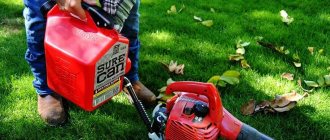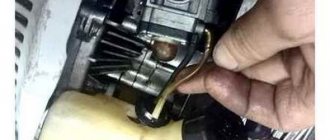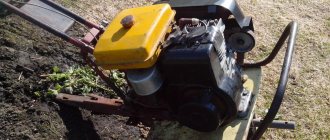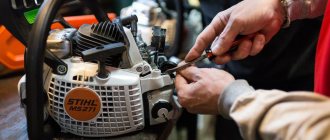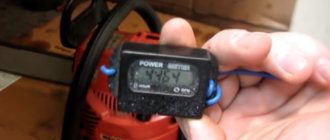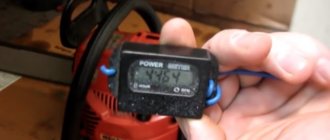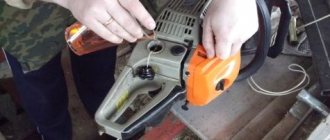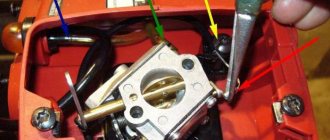Every owner of a chainsaw may encounter problems when using it. The tool refuses to start or stalls during operation. Service center specialists can easily detect the problem and ensure uninterrupted operation of the mechanism. But if it is not possible to go to a workshop or you just want to save money, you can find out the reason and restore the functionality of the tool yourself.
Does your lawn mower stall when it's hot? There is a solution!
The lawn mower stalls when it is hot - this means that there is already a certain amount of fuel in the engine to start the engine, but after 5-10 minutes of operation, it stops working. This behavior of the engine indicates problems with the fuel filter.
The instrument, despite its small dimensions, is a complex technical device. If you study the operating instructions, it turns out that the reasons why the lawn mower does not start are known and can be eliminated. It is necessary to consistently eliminate factors that make it difficult to start the tool. Usually they start with more accessible nodes with easy testing of serviceability.
All the reasons why a lawn mower does not start can be classified according to the specific operation of individual components. The service center classifies faults as follows:
- engine malfunction (piston wear, bearing failure, crankcase crack);
- malfunction of the fuel mixture supply - clogged air filter pores or carburetor malfunction;
- The ignition system does not work;
- mechanical failure - leaking hoses, broken wires under the braid, rupture of tubes.
The user first needs to check whether there is fuel in the tank. Start up according to the instructions, placing the saw on its side. Set the air damper to the “closed” position, pump up the fuel, turn on the ignition and make 3-4 sharp jerks with the starter. If the engine starts, open the air damper. The lawn mower does not start - we repeat the operations with the air damper slightly open.
The brush cutter cannot work for a long time. The gearbox and motor will overheat. You can mow for no more than 15=20 minutes, taking a five-minute break. On a hot afternoon, the operating time is halved. When mowing weeds and sedges, the work time must be reduced.
If the launch fails, we begin to look for the cause of the failure:
Why is it heating up?
In some cases, during operation, you may notice that the tire heats up excessively; there are two reasons for this phenomenon. The first is a manufacturing defect. Such parts are equipped with low-quality bearings, which heat it up during operation. A defective part will heat up and nothing can be done about it, only replace it with a new one.
The second reason is, again, not enough lubrication, or its complete absence. If signs of overheating appear, such as melting of the paint on the tip of the tire and strong smoking, you should stop using the tool and contact a service center.
This is what an overheated chain looks like
The choice of chainsaw tire largely depends on the characteristics of the chainsaw itself. You should only choose components recommended by the manufacturer, taking into account the pitch of the drive sprocket, the width of the chain groove and the shape and size of the shank. The key to long-term service of a chainsaw saw set is the uninterrupted supply of a sufficient amount of lubricant of the appropriate brand. Excessive wear of the bar and chain, as well as their heating, is a sign of improper operation of the saw chain lubrication system. We have highlighted the main points of choice, remember them and take them into account when purchasing, and then you will definitely buy what you really need.
Gasoline is not supplied
To find the source of the breakdown and determine why the device does not pump gasoline, disconnect the gas line from the carburetor. Try pumping fuel. If it feeds slowly, problems may include:
- in the fuel filter, it is clogged with debris;
- in contamination of the gasoline supply channel.
Experts do not fill the container with fuel to the brim. This may damage the device.
Smokes
If your equipment smokes or loses power, pay attention to the engine. Its breakdown may also be indicated by unstable starting, overheating
What to do if the chainsaw stalls when you press the gas
One of the most common questions regarding the operation of this device is: why does the chainsaw stall when you press the gas and what needs to be done to solve this problem? In such a situation, you need to do the following:
- check the fuel filter;
- inspect the fuel hoses for leaks;
- check the muffler;
- try to increase the speed a little;
- Check the condition of the rubber seals on the crankshaft.
How to stop the engine if it has gone into overdrive
You need to know what to do if the engine goes into overdrive. This will help save the life of both the engine and the owner. So, to stop the spread, it is necessary to reduce the fuel supply or completely remove the air supply. If the situation gets out of control while driving, then the best way out is to increase the load. This step will help to somehow normalize work. If a runaway starts and the driver is behind the wheel, he will definitely feel a sudden acceleration
It is necessary to take your foot off the gas pedal and press the brakes - it is important to keep an eye on the cars behind you. The main thing here is to prevent an accident
Experts do not recommend valuing the engine above human life. Let him drive “all the money” and rotate at speeds close to the sky-high.
Stalls at idle
Sometimes the saw stalls at idle, and a clogged muffler is a common cause of breakdown. You can easily clean it yourself; you don’t need a highly qualified specialist for this.
In addition to cleaning, there is another option, but we handle it very carefully so as not to harm the internal parts of the device.
To adjust the carburetor, you need to find two bolts with the letters L and H. The latter needs to be turned, a little, only half a turn. He is responsible for the speed of the tool and, if necessary, will raise the idle speed.
Disassembly and cleaning
To work, we need a shaped screwdriver PH1 and a small, clean, flat surface. Unscrew the four screws to get to the membrane.
Unscrew it, remove the cover, underneath there will be a membrane, it is usually firmly glued to the intermediate gasket, carefully peel it off, the lower gasket is not always removed without deformation, so we do not touch it, lay everything out in the appropriate sequence.
Under the membrane we see a rocker arm that lifts the needle, the rocker arm sits on the rod, and the rod holds the screw and unscrew it, take everything out in place! We unfold the carburetor, and on the reverse side there will be a cover on which the idle speed adjustment screw is located, unscrew it too, and we get this picture.
On the carburetor body itself in the photo we see a large hole in the upper right corner, there is a metal mesh there, we take it out and blow it out, and also carefully insert it in place. Now we check the membrane itself, it should not be oak, when pressed it should freely return to its original state, and the central metal rod should sit dead on the membrane itself, if it rotates freely, then only replacement. But usually, if the carburetor is capricious, we immediately take a carburetor repair kit for Pratner 350-351.
We unscrew the adjusting screws L and H; before assembling them, it is not possible to confuse their different thread diameters. We blow out the carburetor under pressure and check all the mounting holes for wear, and also watch how the needle moves in its seat, it should not bite, and the end should be the same color.
If it is like in the picture, then this is wear on the intake needle due to the presence of dirt particles in the fuel. Such a needle will not provide a seal and fuel will leak, resulting in over-enrichment of the combustible mixture.
When you press the gas, the chainsaw starts to stall - causes and solutions to the problem
A chainsaw is a highly efficient tool that is designed for working with wood. However, the high-speed motor of this tool can be used to perform a number of other tasks, which is achieved through special attachments. Sometimes a malfunction occurs such that the chainsaw stalls when you press the gas, which can be triggered by certain factors. To avoid having to completely disassemble the tool, we will consider all possible causes of this problem with a detailed description of how to eliminate them.
Carburetor operation
When starting the internal combustion engine, the air damper closes. This mode produces a rich mixture. The engine gradually warms up:
- The cylinder walls heat up.
- Heat is transferred to the fuel chamber, the fuel temperature rises, which improves its evaporation during external mixture formation.
The filter elements do not allow abrasive particles contained in the surrounding air to enter the cylinder.
- After warming up, you can open the air damper. Correct idle speed control is responsible for stable operation.
- During operation in a converging diffuser, the air flow moves at high speed. Fuel is sucked into the diffuser, it evaporates, and a working mixture is formed.
- When the throttle valve is opened, the amount of charge supplied increases.
- The turnover is increasing. Power and torque are also higher.
- By closing the throttle, the flow of charge is reduced. Power is reduced.
To regulate the carburetor, there are adjusting screws; they are located on the control panel. The operating mode is set by the position of the levers associated with the damper and throttle. For ease of control, cables are attached to them.
Why does a chainsaw stall under load?
Sometimes the chainsaw is unable to function properly under load. Most often this is caused by improper adjustment or leaking carburetor. In addition, the cause of this problem may be air leaks through the carburetor gasket or crankshaft oil seals. A tool that is unable to function under load will also not be able to reliably maintain idle speed.
Diagnostics begins with checking the carburetor and crankcase for leaks. If air leaks through the crankshaft oil seals are detected, they must be replaced. If air leaks are detected in the carburetor, installing a repair kit of gaskets is required to solve the problem.
If these actions do not lead to the desired result and the engine crankcase and carburetor are sealed, then you need to adjust the carburetor.
If a Husqvarna chainsaw stalls under load, then in case of any deviations in the functioning of the motor, you should first of all check the impulse hose, since this is the most common cause of failure of chainsaws of this brand.
The chain does not rotate
Why doesn't my chainsaw chain rotate when the engine is running even at full speed?
- Leading sprocket. Either it is jammed, or the crown is worn out so much that it is not affected and the chain
does not spin on the chainsaw. In any case, you need to reassemble the sprocket to find out the exact reason why the chain does not turn. If the crown is worn out, it is necessary to replace the sprocket (or the crown, if the sprocket has a prefabricated structure). - The brake chain is jammed. As a result, the sprocket is blocked by the brake mechanism, while the motor runs. Stop the engine and release the brake. If this happens under load, the brake mechanism will have to be changed, as well as the sprocket, since due to the high temperature, many elements can melt and overheat.
Air filter dirty
It is quite easy to verify that the air filter is dirty. You just need to remove it and start the chainsaw without it - if the saw works normally, then that means it’s the problem and you just need to change it or wash it, depending on its type. And don’t be afraid that the chainsaw will work for some time without protection from dust - if there is no dust cloud around you, then everything is in order.
So, remove the air filter. To do this, you need to remove the cover from the top rear part of the chainsaw, which is attached either with screws, or simply with some kind of fastener that you just need to turn or snap off.
If the saw operates normally when the filter is removed after starting, it means it is dirty.
The air filter can be felt or nylon. The first resembles cotton wool or padding polyester, and the second looks like a fine mesh of nylon threads stretched over a plastic body. The felt one needs to be replaced with a new one, but the nylon one can simply be washed in soapy water, dried and put back in place.
Nylon filter Felt filter
Well, we can continue to calmly use the chainsaw.
Carrying out disassembly
Before you begin adjusting the carburetor of the Partner-350 gasoline saw, it is necessary to study the design of the unit in detail. Since it is used almost unchanged in many models, the recommendations below are relevant for the vast majority of them.
When removing elements, you should be as careful as possible, laying them out in the same order in which they were dismantled. This will make the subsequent assembly easier. The top cover is held in place by three bolts, they need to be removed. After this, a layer of foam rubber will become visible, serving as an air filter element. To remove the drive rod, you need to get rid of the gasoline hose. It is impossible to adjust the carburetor of the Partner-350 chain saw without removing the cable tip; this must be done at the next stage. The fuel hose located on the left side of the fitting must be removed. After completing all the above procedures, you can disconnect the carburetor and begin adjusting it. This mechanism is very complex, for this reason, during subsequent disassembly, extreme care must be taken when removing parts. Without this, they are easy to lose due to their small size.
Checking filters and carburetor
A common cause of chainsaw breakdowns is faulty filters or carburetor.
Checking the fuel filter
If the fuel filter is clogged with dirt, it is not able to pass enough fuel through it. As a result, the chainsaw stalls if you press the gas. The fuel burns too quickly, and a new portion of it does not have time to enter the system. If the fuel filter is slightly clogged, a significant reduction in power is observed at maximum engine speed.
Chainsaw fuel filter
Air filter
Contamination of this element makes normal operation of the chainsaw impossible. But many models are equipped with a special compensator, which takes air in a different way. It allows you to do this even with a dirty filter, which has a positive effect on the operational capabilities of the unit.
Location of the air filter and spark plug of the chainsaw
In such cases, the power of the saw drops significantly, but it will not stall. Sometimes a decrease in this characteristic is observed when the piston is worn out.
Carburetor
The principle of operation of a chainsaw carburetor
A common cause of malfunctions of such a tool is carburetor failure. It is recommended to check this element if you have certain skills. It is better to give the device to a specialist who will perform high-quality diagnostics and adjustments using a tachometer.
This is especially true when the saw stalls at idle. It is recommended to check the operation of the muffler. It is because of the accumulation of exhaust gases that the saw stalls at idle and does not work normally. It often happens that the saw is not used for a long time. When they start using it again, they notice that when starting at idle, the unit works well, but when you press the gas, it stalls. The main reason for this negative phenomenon is a stuck injector valve.
To check for the presence of such a malfunction, it is necessary to remove and disassemble the carburetor. To do this, you need to unscrew the two nuts where the air filter was fastened. It is removed together with the engine control lever. The choke control rod must be disconnected from the carburetor.
Removing the carburetor cover
At the next stage, you need to pull this part towards you slightly, disconnecting the fuel supply hose. This must be done especially carefully, having previously prepared a special plug. It will be useful for closing the hose, since fuel will be released from it.
When you have managed to remove the carburetor, you need to clean it of dirt and blow on it. Only then can you try to unwind this part. It is necessary to remove the main cover and use a small bolt to carefully knock out the valve. It should only allow air to flow in one direction. If it goes on both sides, then this part needs to be replaced.
Carburetor disassembled
Possible faults
To get any tool working properly, you must first determine the exact cause of the failure. Let's look at the most common situations in which a chainsaw stalls.
Poor quality fuel
For trouble-free operation of the engine, the quality of the fuel used is important. To keep your saw running smoothly, it is important to use the correct fuel.
Fill the tank with gasoline with the octane rating recommended by the manufacturer.
The second important condition is choosing the right oil. When purchasing, you should give preference to products from brands that produce lubricants with special additives
The saw may stall if the proportions of gasoline and oil are not maintained during refueling. Due to lack of lubrication, the mechanisms jam and the tool stops working.
When mixing, you should use the proportions indicated in the instructions for the saw, and not the data on the oil packaging. The optimal ratio for most tool models is 25 ml of lubricant per 1 liter of gasoline.
For smooth operation of the saw, use AI-92 gasoline and two-stroke oil.
Filters are clogged
In this case, the saw runs idle, but when you press the gas it stalls. Most often this is caused by the use of low-quality gasoline. A clogged filter interferes with the flow of fuel to the engine, so the saw stops under load.
One of the important parts of the tool is the air filter. The performance of a chainsaw depends on its cleanliness and correct choice, which directly depends on the operating conditions of the tool:
- Cotton filter - installed on tools that are used with a saw in the warm season in dry air.
- The HD 2 filter is intended for use of the tool in winter or in dusty conditions (for example, during large-scale logging). Such parts are often equipped with professional tools.
Breather clogged
This small hole on the chainsaw tank is designed to allow air to enter. Depending on the model, it is located in the lid or in one of the walls. A clogged breather creates a vacuum inside the tank, which prevents fuel from entering the carburetor.
Fuel supply interrupted
A broken or damaged pipe is a possible reason why the saw stalls during operation. In this case, the tool starts up, since a small amount of fuel is present in the engine, but refuses to work further.
Storing the saw at sub-zero temperatures will cause the fuel tube to crack. The situation will be corrected only by replacing the part.
Problems with electrical components
Spark plugs are an important element of a chainsaw engine. The tool may stall if carbon deposits accumulate on their surface. Therefore, spark plugs need to be cleaned periodically and changed promptly.
Problems with the power supply can occur if the gap between the ignition coil and the magneto is damaged. This is caused by impacts when operating the saw in difficult conditions. For stable engine operation, the gap should not be more than 0.5 mm.
Expert opinion Dmitry Konstantinovich Levin
The lack of a spark may be due to a clogged fuel filter or depressurization of the tubes. If the spark plugs are wet, it means that during operation of the tool they are filled with gasoline or oil.
Carburetor not adjusted or clogged
Problems with the operation of this unit are indicated by the saw stopping at idle.
The carburetor malfunctions in the following cases:
- clogged jets, nozzles, channels or filters;
- wear of oil seals, cuffs, gaskets;
- incorrect adjustment.
Dirty muffler
The accumulation of carbon deposits in this part leads to loss of power of the tool. The muffler can become clogged if the wrong or low-quality oil is used. Adding too much lubricant to gasoline can also cause clogs.
Poorly lubricated chain
Due to clogging or damage to the oil drive, the tool tire remains dry: the chain jams and the saw stalls during operation. The same problem can arise when using low-quality oil.
Problems "Hot"
If you notice that the chainsaw starts without any problems without warming up, and after warming up it stalls. And it won’t start until it cools down, so there may be several problems here.
Firstly, there may be a leak somewhere in the hose, oil seal or gasket. Secondly, inspect the muffler for carbon deposits. The third reason is the cylinder-piston group (CPG), whether there are any scuffs or irregularities there.
Sometimes a carburetor adjustment is required. Another important cause of malfunction is the ignition coil. In cases where it fails, the spark is lost or becomes very weak, which is not enough to ignite the fuel mixture.
There are cases when the master tries hard to the engine, sometimes cold, sometimes hot, thereby pumping fuel. Here you need to pull yourself together, set the damper to “hot start” and gradually start the tool. At the same time, we reduce the speed to almost idle and it warms up for 40-45 seconds.
How to start a chainsaw correctly?
Before starting the tool, you need to read the operating manual. The instructions for some models indicate that before starting the saw you should turn on the inertia brake to instantly stop the chain. This will make starting the tool safer for the operator. However, if the brake is on, starting the saw will be much more difficult. In practice, it is best to start the saw with the brake off, while adhering to safety regulations.
To properly start a cold chainsaw, you need to follow this procedure:
- First of all, you will need to move the throttle adjustment lever to the lowest position. It must be taken into account that the lever can only be moved to this position when the gas lever is pressed. During this, the carburetor throttle valve will close. To perform further actions, the gas lever must be locked in the pressed position;
- Then you will need to sharply pull the standard starter cable several times. This must be done until the saw motor starts and then stalls. Next, the damper position lever must be moved up one position;
- After this, you need to sharply pull the starter cable again;
- Then you will need to quickly press the throttle lever and release it. In this case, the damper adjustment lever will automatically move to its operating position. The engine speed will drop, which will indicate that the chainsaw is ready for further work.
Checking the main chainsaw systems
If the chainsaw refuses to work normally, you need to make sure that all the conditions required for its normal functioning are provided:
- fuel;
- spark;
- lubricant;
- air.
Then you need to sequentially check the functioning of all its elements. First you need to check the fuel tank. If the reason is not the volume or quality of the fuel, then the likely cause of the malfunction may be the spark plugs. The spark plug gap should not exceed 0.5 millimeters. If it is too small, this means that carbon deposits have deposited on the candles. In this case, you should remove the spark plugs, clean them, then put them back in place and try to start the chainsaw. In addition, it is advisable to completely replace the spark plugs with new ones from time to time, even if they are in good condition.
Then you need to check the condition of the fuel filter and carburetor. Cleaning the fuel filter yourself is not a difficult task, but carburetor repair is best left to specialists.
Chinese and new chainsaw does not start, what could it be?
The popularity of Chinese chainsaws knows no bounds. This is due to their main advantage - affordable cost. At the same time, owners of Chinese chainsaws often have questions about problems starting the engine of the tool. Before you find out why a Chinese chainsaw won’t start, you should note one feature - the design of these tools is no different from Russian, German and other manufacturers. That is why the reason why the chainsaw does not start can be detected based on the algorithm described above.
Chinese chainsaws are very sensitive to fuel quality, so checking the fuel quality comes first in the diagnostic algorithm. The use of low-quality fuel leads to the fact that the tool does not work at full capacity, its service life is reduced, and there are also difficulties with starting
The instructions for the tool indicate the recommended type of gasoline and oil, which are important to use in order for the Chinese chainsaw to work for a long time and at full power
https://youtube.com/watch?v=kUz7KXtDhOs%3F
If you bought a new chainsaw and it does not start, then troubleshooting should begin by returning the tool to the store. Make sure that you start the engine of the tool correctly, and if you cannot achieve a positive result, then you need to return the tool to the store under warranty. Attempting to troubleshoot the problem yourself will leave traces and may void the warranty.
It is recommended to double-check that the fuel mixture is prepared correctly. If everything is done correctly, but the engine of a gasoline tool does not start, then there is a high probability of a manufacturing defect. There can be a defect with any part, but this should already be determined in the store’s service center.
Chainsaw stalls at high speeds - simple carburetor repair
The carburetor of a tool is precisely the mechanism that most owners are afraid to disassemble on their own. The reason is that this mechanism consists of many small parts, the location of which must be remembered during dismantling work. However, not everything is as scary and difficult as it might seem. To understand how the carburetor relates to the problem of the engine stopping when the speed increases, you need to know its operating principle, described on the website.
The chainsaw stalls when you press the gas due to the carburetor if:
- Damaged membrane
- Clogged filter element (mesh in the carburetor). This malfunction may be encountered by tool owners who do not have a fuel filter or it is simply disconnected from the fuel hose.
- Needle sticking, which may be due to the use of an outdated fuel mixture
- Clogged jet channels or clogged carburetor
- Bending the connecting part that combines the membrane with the needle to supply fuel to the fuel chamber of the carburetor. This part is also called the foot, since under the influence of the membrane on it, the needle moves and the channel opens. During operation, this foot may bend (wear out) or break (if broken, the engine will not start). If the foot is bent, it can be straightened, but this does not guarantee that the problem will recur soon, so it is recommended to replace the part
It is recommended to clean and wash the chainsaw carburetor, as well as replace faulty parts and elements. After this, you can put it back, not forgetting to also replace (if worn) the sealing gasket between the carburetor and the adapter.
Where to look for the reason or where to start checking
All chainsaws have the same design and work on the same principle. The structure of a chainsaw can be found in this material. It doesn’t matter much what brand the instrument is - Shtil, Husqvarna, ECHO, Champion, Partner, Sturm and others. A malfunction that manifests itself in the form of a chainsaw stalling when you press the gas can occur equally on both expensive and high-quality tools and on budget Chinese devices. If a problem arises, it needs to be solved.
A chainsaw is a system of mechanisms consisting of parts. Any part in the mechanism can fail, which will lead to partial or complete failure of the tool. If the tool’s engine starts, this does not mean that the chainsaw is fully operational. When the engine stops working when the speed increases, there are corresponding reasons for this. In case of this malfunction, you should first pay attention to a number of the following tool mechanisms:
- Gas tank - make sure there is fuel. If there is sufficient fuel, you should also check the serviceability of the fuel filter, the connection of the supply hose to the carburetor, and also make sure that the breather is working
- Spark plug - if everything is in order with the fuel supply system, then you should check the serviceability of the spark plug. By the color of the carbon deposits on the spark plug electrodes, you can determine the cause of the breakdown. If the carbon deposits are brown, then the spark plug, ignition and fuel supply system are operating in the correct mode. The presence of black carbon deposits indicates an ignition malfunction, and if the electrodes are wet, then the carburetor should be checked
- Muffler - over time, carbon deposits accumulate in the exhaust gas removal device, which helps reduce the throughput of the mechanism. If the exhaust gases have nowhere to go, they will interfere with the normal operation of the engine. In addition to a decrease in power, if the muffler is faulty, the engine will stop working when the speed increases
These are the main parts and mechanisms that should be checked first if a malfunction occurs when the chainsaw stalls when the accelerator is pressed. There are other reasons why a chainsaw engine stalls when the gas trigger is pressed. What else can contribute to the occurrence of this malfunction, as well as the specifics of troubleshooting, we will find out further.
Adjusting the carburetor when the engine stalls when revving up
If the check shows that the fuel supply system, muffler and spark plug are working properly, then you need to look for a breakdown in other places. Initially, do not rush to disassemble the cylinder-piston group or change the carburetor. It is recommended to start repairs by adjusting the carburetor. For this, all chainsaws have special adjustment screws. They are designed to adjust idle speed, as well as adjust fuel supply at low and high speeds. A detailed description of how to adjust the carburetor of a chainsaw is described on the website.
Today we will look at the features of setting the carburetor at maximum speed. You can make sure that the chainsaw is not developing full power using a tachometer. If there is no device, then you can make sure that the engine is not developing maximum speed by ear. We are interested in the screw on the carburetor. Which is designed for high speed settings. It is usually denoted by the Latin letter "H", which is short for the word "High" (high or large).
To set up high speed chainsaws you will need to perform the following manipulations:
- Screw screw H clockwise until it stops
- Next you need to loosen it by 1.25-1.5 turns
- Start the tool and test the speed performance
It is recommended to make the adjustment using a tachometer, but if you don’t have one, you can check the maximum speed when working with the tool under load.
This is interesting! If you often work with a chainsaw, then you will need to purchase a tachometer, as it allows you to set the engine to operate as efficiently as possible, which affects the fuel consumption and power of the unit.
After simply adjusting the carburetor, you can fix the problem with the engine stopping when the speed increases. It should be noted that the chainsaw carburetor must be adjusted regularly depending on the frequency of use of the tool. It is not difficult to do this yourself, but precise adjustments can be achieved in one case - if you use a tachometer.
Muffler inspection and repair
Clogged mufflers should be left to soak in warm water and detergent, then wiped thoroughly and dried.
A malfunction of the muffler leads to a drop in the power of the tool when working and stopping in idle mode.
Despite the apparent simplicity of this detail, it is also important to keep an eye on it. Quite often the muffler becomes clogged
During operation, it is possible that wood dust, sawdust, and resin particles may get on the grate. High temperatures cause them to stick and accumulate; exhaust gases also form deposits on the surfaces of the spark arrestor and other parts. The layer that increases over time reduces the throughput of the muffler and interferes with the normal removal of exhaust gases. The engine, figuratively speaking, is choking.
Repairing this unit is not difficult and is within the capabilities of many tool owners. The device should be removed from the engine, the holes should be covered with a rag or other material. If the resulting layer is too hard, all parts can be left to soak in warm water and detergent. After the plaque has softened, the parts should be washed with a rag or soft brush and wiped thoroughly. Inaccessible areas can be blown with compressed air or dried with a hairdryer. The use of mechanical means of removal is not advisable.
For normal operation of the muffler over a long period of operation, you should use lubricants recommended by the manufacturer, monitoring their expiration dates. The mixture must be prepared immediately before work and consumed completely.
The main reasons for chainsaw failure
Although all possible breakdowns in certain parts of the chainsaw system have been described, their solution may not be enough. It is necessary to dwell on some aspects of problem solving in more detail.
Checking the fuel mixture and spark plugs
The fuel mixture that is poured into the chainsaw must be pre-prepared. First of all, we must not forget that when producing a fuel mixture, it is necessary to use only high-quality components approved by the operating book . We also must not forget that it is best to drain the fuel before storing the equipment or between seasons when the chainsaw is idle.
Checking spark plugs can be divided into several subsections. First, you need to remove the spark plugs and check their tips for fuel. This can happen from time to time when the chainsaw is started. Most often, this happens to inexperienced users who simply forget to follow the rules of sequence when starting a chainsaw at cold speeds.
Secondly, there may be carbon on the spark plugs, which simply clogs the connection gap. The gap should have a distance of 0.5 to 0.65 mm. Remove carbon deposits using fine-grained sandpaper or a brush with metal hairs.
Checking and cleaning the muffler
It happens that checking absolutely all components from the hose to the spark plugs does not give results and the chainsaw continues to stall when you press the gas. In this case, all that remains is to check the muffler . This piece of equipment is very often the cause of breakdown. The bottom line is that over a long period of use of a chainsaw, a large amount of deposits accumulates in the muffler. In addition, sediment appears if you fill in a low-quality fuel mixture or use the equipment incorrectly.
The first thing you need to do is check the muffler for carbon deposits. To do this, it must be dismantled. First, the nuts are unscrewed, the muffler, plate and reflector are removed. The main thing is not to tear off the studs on the fastenings during dismantling. If carbon deposits are found inside, it means that the muffler needs to be cleaned, and this can be done in two ways.
The easiest way to clean the muffler can be applied to collapsible chainsaws. To do this, you need to do several steps:
- After dismantling the muffler, the entire internal part is treated with a metal brush in order to remove the main layer of carbon deposits.
- After the top part of the sediment has been removed, the inside of the muffler is cleaned with fine-grit sandpaper.
- To improve the cleaning effect, the muffler is treated with a chemical solution, and then dried well and installed back on the chainsaw.
When removing carbon deposits, the main thing is not to use too much force so as not to deform the muffler structure.
The second option is only suitable for models with a non-separable design, and here carbon deposits are quite difficult to remove in all places of the muffler. It is simply physically impossible to reach all parts of the muffler , but before starting the main cleaning, it is recommended to carry out mechanical cleaning at least in those places where the brush can reach.
After this, shot is poured into the muffler, which, when the chainsaw is shaken, removes carbon deposits, but this method is not the most effective. It is best to use special chemicals that are poured into the system and so the equipment costs several hours. After this, the muffler is purged.
Naturally, there is no guarantee that chemicals will help completely remove carbon deposits, but this will comparatively reduce the amount of sediment on the walls of the muffler.
Identifying and eliminating obvious chainsaw faults.
To determine the reason why the chainsaw does not start or stalls when starting, it is necessary to troubleshoot the tool. The essence of the procedure is a sequential inspection of the condition and operation of the main working elements of the saw engine. At this stage we check:
- Presence of a spark on the spark plug;
- Fuel supply;
- Filter status;
- Operation of the breather built into the fuel cap of the stalling unit;
- Functioning of the exhaust channel.
Checking the spark on the spark plug and eliminating the causes.
The first step in finding the reasons why a gasoline saw does not start is to check the spark on the spark plug. There are many factors that influence the operation of this element. However, the main ones at the initial stage of tool troubleshooting are:
- Incorrect carburetor adjustment;
- The presence of more than the required amount of oil in gasoline;
- Air filter clogged.
All of them contribute to the formation of carbon deposits on the spark plug electrodes. In 50 cases out of 100, saws do not start when cold due to the lack of a spark due to carbon deposits on the electrodes and their corrosion. The result is either a decrease in the gap or an increase in it.
Checking the spark plug of a non-working chainsaw
Checking for spark is quite simple. To do this you will need:
- Remove the tip of the high-voltage wire;
- Unscrew the spark plug;
- Put the tip back on;
- Place the candle skirt against the cylinder;
- Start with the starter.
If at the moment the chainsaw engine starts, a good spark is observed between the electrodes, then everything is in order with the ignition unit. If it is not there, then it is worth cleaning the element itself and checking the electrode gap. If necessary, use a special probe to adjust the distance between the contacts.
There may be no spark at the spark plug for other reasons. The main malfunctions that affect poor starting of the chainsaw and unstable operation of the internal combustion engine at idle, which can cause the tool to stall, include the following:
- Overfilling of the spark plug channel with fuel;
- Lack of contact between the high-voltage cradle and the tip of the spark plug;
- Failure of the ignition unit.
How to start a cold chainsaw if the spark plug channel is constantly flooded with gasoline? You can fix the problem while starting the tool using the following algorithm:
- Unscrew the spark plug with a special wrench;
- Wipe it with a clean and dry cloth;
- Dry for 20...30 minutes;
- Remove carbon deposits with a file and adjust the gap between the electrodes;
- Drain the remaining fuel from the spark plug channel and dry it;
- Collect everything and try to start the mechanism.
If there is no spark due to poor contact of the high-voltage cradle with the tip of the spark plug, it is necessary to check the connection. The test can be carried out using a regular tester. If a defect is detected and corrected, the chainsaw should start without any problems.
If the check shows that the contact is reliable, but the saw still does not start, look for the reason in the ignition unit. As a rule, a faulty unit cannot be repaired or restored. This will require a complete replacement.
We determine the availability of fuel and its supply.
First, you need to make sure that there is a fuel mixture in the tank of the chainsaw that does not want to start, and that it is properly supplied to the carburetor. With a full tank, check how the mixture is supplied through the gas line. We disconnect the fuel system pipe from the carburetor and try to pump it up. In case of complete order, when pumping, gasoline will be supplied jerkily in accordance with the standards set by the manufacturer. Weak fuel supply or its absence can result from:
- The fuel supply channel is clogged;
- Fuel filter clogged with debris.
Problems associated with improper operation of the fuel system
The tool stalls if the integrity of the fuel line is broken or the wrong fuel mixture ratio is selected. Especially often, such tube defects occur when the instrument is kept for a long time in a room where sudden temperature changes were observed. When refueling the device, you must strictly follow the manufacturer's recommendations regarding the ratio of gasoline and oil.
Proportions of oil and gasoline for a chainsaw
Related video: Chainsaw stalls when pressing gas
Publications on the topic
Instructions for setting up a chainsaw carburetor Troubleshooting a Husqvarna 142 chainsaw What to do if the Shtil 180 saw does not start - finding the cause
No. 10. Chain brake does not work
All chainsaws are equipped with a main and inertial (emergency) brake. The latter turns on only when a backfire occurs. The main brake is designed to stop the chain while the engine is running. Why does the chain on the chainsaw jam and it doesn’t stop? Option two:
- The brake band is badly worn and does not provide sufficient stopping effect. The brake band needs to be replaced.
- Contamination of the tape. When working, debris may become clogged in the under-cover space: shavings, sawdust, dirt, etc. Debris is blocking the brake mechanism, so if the brake does not work, you need to clean the brake mechanism.
Characteristics of the Partner 350 chainsaw
This model is in great demand among consumers, but most often it is purchased by summer residents for work on their own plots. The saw is used not only for preparing firewood, but also in construction.
In general, Partner 350 chainsaws are distinguished by their compact dimensions. They are equipped with a rather massive engine. Their main advantages are easy starting and reliable operation due to a well-made electric ignition system and fuel pump.
Using such a chainsaw is not at all dangerous. It has a built-in protective system that automatically activates the inertial brake for the chain. In the same mode, its lubrication is carried out.
There will be no problems starting the Partner chainsaw even in winter, since it has a fuel primer. The starter drum is equipped with an impeller that helps clear dirt. In addition, the manufacturers have equipped the tool with the CCS system. This design traps residual particles and is also used when using the air filter for a long time.
To increase the service life of the chainsaw, the developers made chrome-plated walls on the piston group cylinder. This model also has an ergonomically shaped handle and an anti-vibration system.
